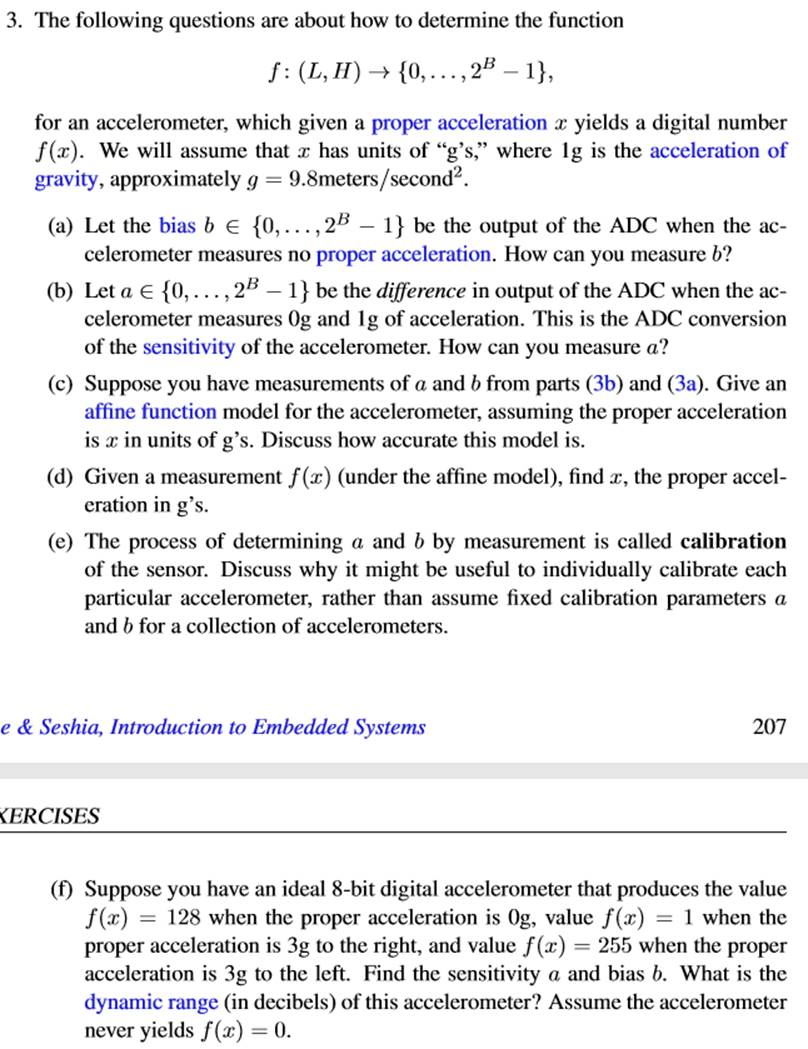2. The dynamic range of human hearing is approximately 100 decibels. Assume that the smallest difference in sound levels that humans can effectively discern


2. The dynamic range of human hearing is approximately 100 decibels. Assume that the smallest difference in sound levels that humans can effectively discern is a sound pressure of about 20 Pa (micropascals). (a) Assuming a dynamic range of 100 decibels, what is the sound pressure of the loudest sound that humans can effectively discriminate? (b) Assume a perfect microphone with a range that matches the human hearing range. What is the minimum number of bits that an ADC should have to match the dynamic range of human hearing? 3. The following questions are about how to determine the function f: (L, H) {0,..., 2B - 1}, for an accelerometer, which given a proper acceleration a yields a digital number f(x). We will assume that has units of "g's," where lg is the acceleration of gravity, approximately g = 9.8meters/second. (a) Let the bias b = {0,...,2B - 1} be the output of the ADC when the ac- celerometer measures no proper acceleration. How can you measure b? (b) Let a (0,..., 2B-1} be the difference in output of the ADC when the ac- celerometer measures Og and 1g of acceleration. This is the ADC conversion of the sensitivity of the accelerometer. How can you measure a? (c) Suppose you have measurements of a and b from parts (3b) and (3a). Give an affine function model for the accelerometer, assuming the proper acceleration is a in units of g's. Discuss how accurate this model is. (d) Given a measurement f(x) (under the affine model), find x, the proper accel- eration in g's. (e) The process of determining a and b by measurement is called calibration of the sensor. Discuss why it might be useful to individually calibrate each particular accelerometer, rather than assume fixed calibration parameters a and b for a collection of accelerometers. e & Seshia, Introduction to Embedded Systems KERCISES 207 (f) Suppose you have an ideal 8-bit digital accelerometer that produces the value f(x) = 128 when the proper acceleration is Og, value f(x) = 1 when the proper acceleration is 3g to the right, and value f(x) = 255 when the proper acceleration is 3g to the left. Find the sensitivity a and bias b. What is the dynamic range (in decibels) of this accelerometer? Assume the accelerometer never yields f(x) = 0.
Step by Step Solution
3.47 Rating (163 Votes )
There are 3 Steps involved in it
Step: 1

See step-by-step solutions with expert insights and AI powered tools for academic success
Step: 2

Step: 3

Ace Your Homework with AI
Get the answers you need in no time with our AI-driven, step-by-step assistance
Get Started


